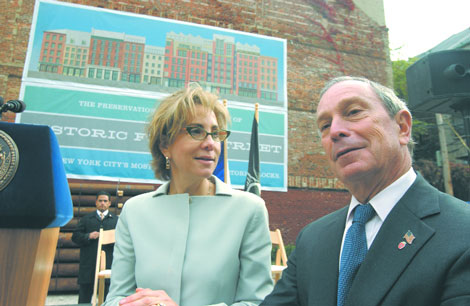By Josh Rogers
Many people living Downtown fear that they will be living in the middle of a construction zone for the next decade, but Kit White couldn’t be happier to hear piles going into the ground outside his window in the South St. Seaport.
“This is the sweetest noise I ever heard,” White said last week. “I’ve been waiting for this for 20 years.”
White, who restored a Seaport building of his own, does not get thrills from noise, but he is excited the neglected 19th century buildings on his block are being renovated. The 14 parcels, which include three vacant sites, are on Front St. and Peck Slip.
Yarrow L.L.C., a group of developers that includes Frank Sciame Jr., Richard Berry and Douglas Durst, bought the properties form the city after two development teams had failed over the last 15 years.
Madelyn Wils, chairperson of Community Board 1, praised Mayor Mike Bloomberg for directing his Economic Development Corp. to look beyond the highest bidders to find developers who would be willing to take on the Seaport’s high construction costs.
“Mayor Bloomberg has succeeded where three administrations had not — in getting this project off the ground,” Wils said at a ceremony last Wednesday on Front St. “The policy of 15, 20 years of looking for the highest bidder only ended up in lawsuits with the city.”
Sciame said work will be done simultaneously on the $47-million project to build 96 market-rate rental apartments and ground-floor retail spaces on the sites. Because of the uncertain foundations and unforeseen circumstances, he did not know which building will be the first to open early in 2005.
“We are doing the whole thing,” said Sciame, whose office is in the Seaport. “It’s not going to be phased.”
Cook + Fox Architects have designed the restoration and new buildings on the site. There will be more glass used in the new buildings to distinguish them from the red-brick buildings, some of which were built 175 years ago and which used to serve the shipping industry.
John Evans, an executive with Sciame Development, said the piles have to be carefully put into the ground and they can’t use noisier, less-costly pile drivers because of the timber mat foundations.
The buildings are some of the oldest in the city, but some of the latest technology is being used to add environmentally friendly elements to the buildings. Workers have already dug several narrow geothermal wells 1,600 feet below the surface that will be used to help cool the buildings. The eight-inch wide wells need to go that low in order to insure the water temperature remains at 55 degrees. Solar energy will also be used for some of the power.
The buildings’ green elements drew Tim Carey, who is not often seen east of West St., let alone Water St. Carey, the president and C.E.O. of the Battery Park City Authority, which has its own green building guidelines, said he was pleased to see conservation measures in historic areas as well as in B.P.C. He is on the board of the New York State Energy Research and Development Authority, which is working with the developers on Front St.
Bloomberg said in one sense it is sad that the shipping industry no longer is active in the area, but said the movement of the Fulton Fish Market to modern facilities in the Bronx’s Hunt’s Point in the Bronx next year will help both areas. Jobs will come to the Bronx, and the Seaport will be opened up for more modern uses, in preserved, historic buildings, he said. The mayor suggested that the reasons for keeping the market near the East River no longer existed since the fish have been trucked into the area for decades.
“We have changed,” Bloomberg said last week. “We have gotten better, but we have not forgotten our past…The truth is the fish don’t show up on boats anymore.”
C. Virginia Fields, Manhattan’s borough president, sporting a Front St. scarf given out by the developers, said, “here at the river’s edge is where New York came alive and began its rise to become the world’s leader.”
Berry said he and his partners would not have been able to proceed without $47 million in Liberty Bonds, a federal, tax-free bond program, which passed Congress after the Sept. 11 attacks. “The Liberty Bond program was absolutely essential to the viability of this project,” said Berry. “Absolutely.”
The bonds can be used on residential and commercial projects in Lower Manhattan and on office projects all over the city. The legislation has come under fire from some because it has not been used to finance many affordable apartments and it has been used for some Midtown projects.
The Front St. bonds received less criticism than others since they are being used to restore historic buildings in a landmark district.
Josh@DowntownExpress.com



































